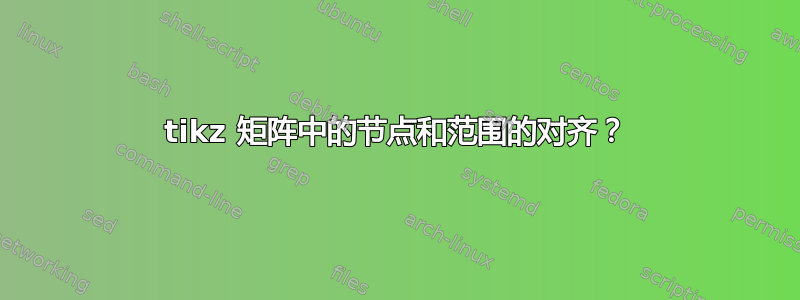
我试图修复下图中箭头的位置,但没有成功。我希望箭头在矩阵单元格中居中(水平和垂直),无论它们指向哪个方向。
箭头由 LARROW RARROW 和 DARROW 宏定义。

梅威瑟:
\documentclass{article}
\usepackage{tikz}
\usetikzlibrary{shapes.multipart,shapes.gates.logic.IEC,shapes.arrows,positioning,decorations.markings}
\begin{document}
\begin{tikzpicture}[use IEC style logic gates, LFSR/.style={
rectangle split, rectangle split horizontal=true, rectangle split parts=#1, draw, anchor=center}, ARROW/.style={draw,thick,single arrow,single arrow head extend=3pt,transform shape}]
\def\Byte(#1,#2,#3,#4){%
\node[LFSR=3,name=#1] {\nodepart{one}#2\nodepart{two}#3\nodepart{three}#4};
}
\def\LFSR(#1,#2,#3,#4){%
\begin{scope}[decoration={
markings,
mark=at position 0.6 with {\arrow{latex}}}]
\Byte(LFSR0,#1,#2,#3)
\node[xor gate, draw, logic gate inputs=nn, logic gate input sep=0.3cm, rotate = 180, below = 1.4cm of LFSR0.one, xshift=2mm, xor gate symbol ={\scalebox{-1}{\small=1}}, logic gate symbol align = {bottom}] (Xor) {\parbox[t][0.75cm]{0.7cm}{\scalebox{-1}{\small XOR}}};
\draw (LFSR0.two south) |- (Xor.input 2);
\draw (LFSR0.three south) |- (Xor.input 1);
\draw (Xor.output) -- ++(left:3mm) node[anchor=north,inner sep=0pt] (hook1) {};
\draw[postaction={decorate}] (hook1) |- node [near start, left] {#4} (hook1|-LFSR0.west);
\draw (hook1|-LFSR0.west) -- (LFSR0.west) {};
\draw[-latex] (LFSR0.one north) ++(up:1mm) node[anchor=center,inner sep=0pt] (hook2) {} -- (LFSR0.three south |-hook2);
\end{scope}
}
\def\RARROW{\node[rectangle,draw] {
\parbox[b][1cm]{0pt}{\begin{tikzpicture}
\node[ARROW] {};
\end{tikzpicture}}
};
}
\def\LARROW{\node[rectangle,draw,rotate=180] {
\parbox[t][1cm]{0pt}{\begin{tikzpicture}
\node[ARROW] {};
\end{tikzpicture}}
};
}
\def\DARROW{\node[rectangle,draw,align=center] {
\begin{tikzpicture}
\node[ARROW,rotate=-90] {};
\end{tikzpicture}
};
}
\matrix[row sep=0, column sep=2.5mm]{
\LFSR(1,1,1,0) &\RARROW& \LFSR(0,1,1,0) & \RARROW & \LFSR(0,0,1,1) & \RARROW & \LFSR(1,0,0,0)\\
\node[anchor=east,minimum height=9mm]{$t=0$}; & &
\node[anchor=east,minimum height=9mm]{$t=1$}; & &
\node[anchor=east,minimum height=9mm]{$t=2$}; & &
\node[anchor=east,minimum height=9mm]{$t=3$}; \\
& & & & & & \DARROW\\
\LFSR(1,1,1,0) &\LARROW& \LFSR(1,1,0,1) &\LARROW& \LFSR(1,0,1,1) &\LARROW& \LFSR(0,1,0,1)\\
\node[anchor=east,minimum height=9mm]{$t=7$}; & &
\node[anchor=east,minimum height=9mm]{$t=6$}; & &
\node[anchor=east,minimum height=9mm]{$t=5$}; & &
\node[anchor=east,minimum height=9mm]{$t=4$}; \\
};
\end{tikzpicture}
\end{document}
答案1
下面我给出了针对您的问题的解决方案(呃...稍微修改了一下=)

我重写了代码,希望它不会太难理解。
\documentclass [tikz] {standalone}
\usetikzlibrary{calc}
\usetikzlibrary{matrix}
\usetikzlibrary{fit}
\usetikzlibrary{shapes.arrows}
\usetikzlibrary{shapes.gates.logic.IEC}
\tikzset{
bit/.style = {draw, thick, minimum size = 1 cm, anchor = west}
, port/.style = {draw, thick, minimum size = 2 cm}
, space/.style = {minimum size = 1 cm}
, flow/.style = {->, thick}
, label/.style = {anchor = east}
, inside/.style = {minimum size = 1 cm}
, next/.style = {single arrow, draw, minimum size = 8mm}
}
\newcounter{cellcounter}
\newcommand{\myarrow}[1]{
\begin{tikzpicture}
\node [next, rotate = #1]{};
\end{tikzpicture}
}
\pgfmathsetmacro{\inputonedistance}{1 / 3}
\pgfmathsetmacro{\inputtwodistance}{2 / 3}
\newcommand{\mycell}[5]{
\begin{tikzpicture} [use IEC style logic gates]
\node [port] (port) {};
\node [inside, anchor = north] (port symbol) at (port.north){\texttt{=1}};
\node [inside, anchor = south] (port name) at (port.south){\LARGE \texttt{#2}};
\coordinate (port right 1) at ($(port.north east)!\inputonedistance!(port.south east)$);
\coordinate (port right 2) at ($(port.north east)!\inputtwodistance!(port.south east)$);
\node [space, anchor = south east] (space 0) at (port.north east) {};
\node [bit, anchor = south] (bit 0) at (space 0.north east) {\texttt{#3}};
\node [bit] (bit 1) at (bit 0.east) {\texttt{#4}};
\node [bit] (bit 2) at (bit 1.east) {\texttt{#5}};
\node [space, anchor = south] (space 1) at (bit 0.north) {};
\node [space, anchor = south] (space 2) at (bit 2.north) {};
\draw [flow] (bit 1) |- (port right 1);
\draw [flow] (bit 2) |- (port right 2);
\draw [flow] (space 1.center) |- (space 2.center);
\node [space, anchor = south west] (space 3) at (port.north west) {};
\node [space, anchor = south east] (space 4) at (space 3.north west) {};
\node [space, anchor = east] (space 5) at (port.west) {};
\node [label] (label 1) at ($(space 4)!0.5!(space 5)$) {\texttt{#1}};
\draw [flow] (port) -| (label 1.east) |- (bit 0);
\draw [flow] (port) -| (label 1.east) |- (bit 0);
\node [fit = (port) (bit 2) (label 1) (space 2)] (base) {};
\node [anchor = north] at (base.south) {\(t = \thecellcounter\) \stepcounter {cellcounter}};
\end{tikzpicture}
}
\begin{document}
\begin{tikzpicture}
\matrix (m) [matrix of nodes, nodes in empty cells, nodes = {minimum size = 2cm}]{
& & & & & & & & & & & & & & \\
& & & & & & & & & & & & & & \\
& & & & & & & & & & & & & & \\
& & & & & & & & & & & & & & \\
& & & & & & & & & & & & & & \\
& & & & & & & & & & & & & & \\
& & & & & & & & & & & & & & \\
};
\node at (m-4-2) {\mycell{0}{XOR}{1}{1}{1}};
\node at (m-2-6) {\mycell{0}{XOR}{0}{1}{1}};
\node at (m-2-10) {\mycell{1}{XOR}{0}{0}{1}};
\node at (m-2-14) {\mycell{0}{XOR}{1}{0}{0}};
\node at (m-6-14) {\mycell{1}{XOR}{0}{1}{0}};
\node at (m-6-10) {\mycell{1}{XOR}{1}{0}{1}};
\node at (m-6-6) {\mycell{1}{XOR}{1}{1}{0}};
\node at (m-3-4) {\myarrow{45} };
\node at (m-2-8) {\myarrow{0} };
\node at (m-2-12) {\myarrow{0} };
\node at (m-4-14) {\myarrow{270}};
\node at (m-6-8) {\myarrow{180}};
\node at (m-6-12) {\myarrow{180}};
\node at (m-5-4) {\myarrow{135}};
\end{tikzpicture}
\end{document}


